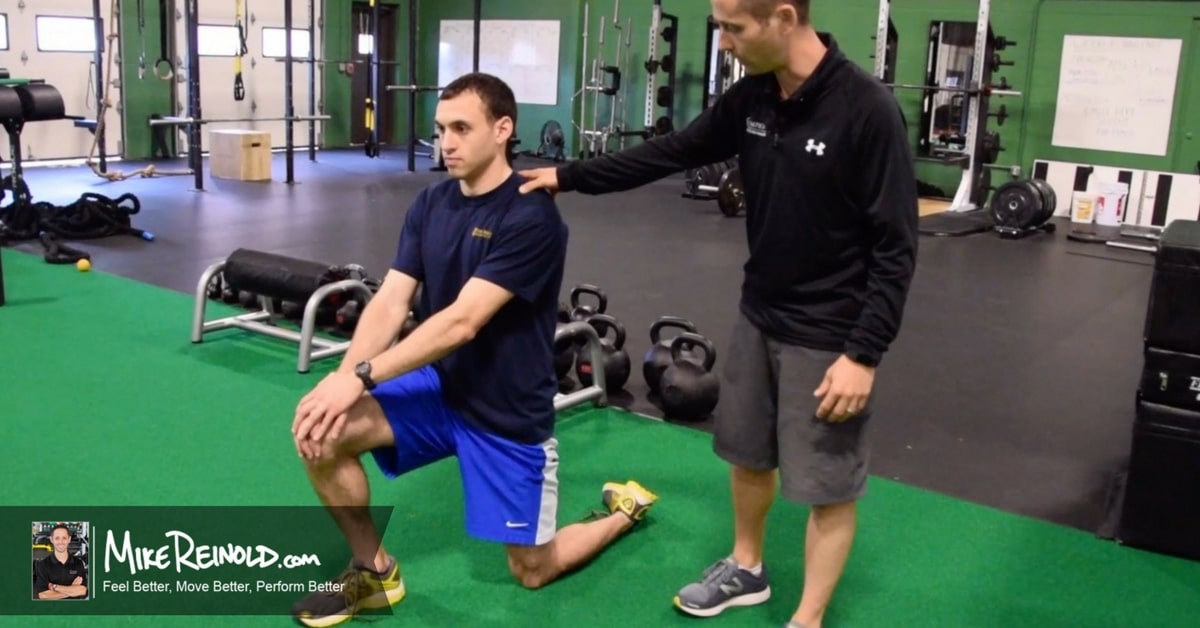The hip flexor stretch has become a very popular stretch for the iliopsoas muscle, and rightly so considering how many people live their lives in an anterior pelvic tilt.
However, this seems to be one of those stretches that I see a lot of people either performing incorrectly or too aggressively. I talked about this in a recent Inner Circle webinar on 5 common stretches we probably shouldn’t be using, but I wanted to expand on the hip flexor stretch as I feel this is pretty important.
I think the best hip flexor stretch is something that I call the “true hip flexor stretch.”
It’s been awesome to see so many people on the internet start adopting this stretch since I first started teaching it, so I thought it would be worth sharing more details to really help people perform this iliopsoas stretch well.
I call it the true hip flexor stretch as I want you to truly work on stretching the hip flexor and not just torque your body into hip and lumbar extension.
The Wrong Way to Stretch the Hip Flexors
It’s very easy for the body to take the path of least resistance when stretching. People with tight hip flexors and poor hip extension often just end up compensating and either hyperextend their low back or stress the anterior capsule of the hip joint.
I explain this in more detail in this video, notice how she is really just hyperextending her already hypermobile low back:
The good thing is, there’s a simple and very effective fix. Once you adjust and perform the true hip flexor stretch, most people say they never felt a stretch like that before, hence the name “true hip flexor stretch.”
The Best Hip Flexor Stretch
To perform the true hip flexor stretch, you want to de-emphasize hip extension and focus more on posterior pelvic tilt. Watch this video for a more detailed explanation:
How to Perform the True Hip Flexor Stretch
Follow these four steps to perform the true hip flexor stretch
- Move to the Half-Kneeling Position
Kneel down on the ground with one knee up and one knee down. The side that you want to stretch should have the knee on the ground
- Squeeze Your Glutes
Start the stretch by simply contracting your glute muscles and think you want to round your back slightly and pull your tailbone down.
- Place Your Hands on Your Knee and Push Down
Once you have performed a posterior pelvic tilt by contracting your glutes, reinforce this by placing your hands on your other knee and gently pushing down. This will contract your anterior core.
- Lean Forward
Many people will already be feeling the true hip flexor stretch at this point, but if you can, gently lean in 2-3 inches without losing your posterior pelvic tilt. This should really help you feel the stretch in your anterior hip.
Key Points
- There is a difference between a quadriceps stretch and a hip flexor stretch. When your rationale for performing the stretch is to work on stretching your hip flexor, focus on the psoas and not the rectus femoris.
- Keep it a one joint stretch. Many people want to jump right to performing a hip flexor stretch while flexing the knee. This incorporates the rectus and the psoas, but I find far too many people can not appropriately perform this stretch. They will compensate, usually by stretching their anterior capsule too much or hyperextending their lumbar spine.
- Stay tall. Resist the urge to lean into the stretch and really extend your hip. Most people are too tight for this, trust me. You’ll end up stretch out the anterior hip joint and abdominals more than the hip flexor.
- Make sure you incorporate a posterior pelvic tilt. Contract your abdominals and your glutes to perform a posterior pelvic tilt. This will give your the “true” stretch we are looking for when choosing this stretch. Many people wont even need to lean in a little, they’ll feel it immediately in the front of their hip.
- If you don’t feel it, squeeze your glutes harder. Many people have a hard time turing on their glutes while performing this stretch, but it is key.
- If you still don’t feel it, lean in just a touch. If you are sure your glutes and abs are squeezed and you are in posterior pelvic tilt and still don’t feel it much, lean in just a few inches. Our first progression of this is simple to lean forward in 1-3 inches, but keep your pelvis in posterior tilt.
- Guide your hips with your hands. You can also start this stretch with your hands on your hips so I can teach you to feel posterior pelvic tilt. Place your fingers in the front and thumbs in the back and cue them to posterior tilt and make their thumbs move down.
- Progress to add core engagement. Once they can master the posterior pelvic tilt, I usually progress to assist by curing core engagement. You can do this by pacing both hands together on top of your front knee and push straight down, or by holding a massage stick or dowel in front of you and pushing down into the ground. Key here is to have arms straight and to push down with you core, not your triceps.
I use this for people that really present in an anterior pelvic tilt, or with people that appear to have too loose of an anterior hip capsule.
In fact, this has completely replaced the common variations of hip flexor stretches in all of our online training programs at Champion. This works great for people with low back pain, hip pain, and postural and biomechanical issues related to too much of an anterior pelvic tilt.
Give the true hip flexor stretch a try and let me know if you agree that this is the best hip flexor stretch.





